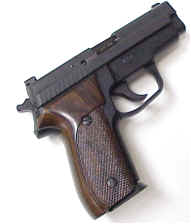 I’m what you’d call a new gun specialist. Fundamentally, that means I buy guns chambered for new cartridges, gripe about not being able to get ammo, dies and handloading data, then lose interest as soon as those problems no longer exist – only because I have nothing left to complain about.
I’m what you’d call a new gun specialist. Fundamentally, that means I buy guns chambered for new cartridges, gripe about not being able to get ammo, dies and handloading data, then lose interest as soon as those problems no longer exist – only because I have nothing left to complain about.
When I first purchased my P229, the .357 SIG cartridge had been out there for awhile, but people were still deeply embroiled in the mind numbing “locate on the case mouth or locate at the shoulder” debate. In fact, straight case handgun guys were intimating the SIG round was the work of the devil, with possible ties to the late Elmer Keith.
Knowledgeable writers suggested reloading the 357 SIG cartridge was best reserved for seasoned and skilled handloaders, indicating extraordinary steps had to be taken with handloads to ensure the gun and cartridge would fire reliably. Still, just about everyone continues to agree, this is a terrific round with lots of power and accuracy, with a high degree of performance potential.
During my initial experience with the 357 SIG I didn’t have a major problem with factory ammo, although some of it appeared to be dimensionally marginal, but I did have a heck of a time with handloads. The symptoms pointed to excessive headspace, but I couldn’t locate a proper set of headspace gauges to help isolate the problem. I eventually found a way to use the barrel of the P229 as a fixture for measuring relative headspace as documented in the original article which is still plopping around Real Guns at https://www.realguns.com/articles/001.htm. As a result of this experiment, I arrived at several conclusions –
-
The case must headspace on the shoulder
-
The shoulder must be located approximately .649″ from the case head
-
I needed set my sizing die in a non-standard position to properly locate the case shoulder
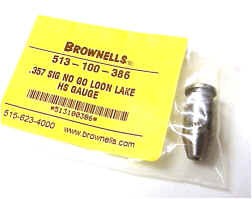 Once I accepted these basic propositions, all of my problems disappeared, and the P229 became one of my favorite pistols – so I locked it away and lost interest, at least until now. I was sitting at my desk, pretending to be working, but really just paging through the Brownellscatalog, knowing there must be some gadgetry I needed to buy. Fortunately, newly listed go/no-go gauges for the 357 SIG jumped right out at me.
Once I accepted these basic propositions, all of my problems disappeared, and the P229 became one of my favorite pistols – so I locked it away and lost interest, at least until now. I was sitting at my desk, pretending to be working, but really just paging through the Brownellscatalog, knowing there must be some gadgetry I needed to buy. Fortunately, newly listed go/no-go gauges for the 357 SIG jumped right out at me.
Headspace gauges typically exist as a three piece set: a “go” gauge, where the gauge is cut to the minimum SAMMI chamber length, a “no-go” where the gauge is cut to slightly more than the maximum SAMMI chamber length and finally a way oversized “field” gauge. A action of a firearm in good condition should easily close over the go gauge, will just barely not close over the no-go gauge and won’t come close to ingesting the field gauge. If the firearm’s action closes over a field gauge, the gun is in serious need of repair and should not be fired. Since I knew I didn’t have a problem with too small of a chamber, I placed an order for a “no-go” gauge from Brownells. At $25, the gauge seemed an inexpensive and useful tool to verify safe gun specs for the present, and potentially verify a new barrel fit sometime in the future.
What is this thing called, headspace ?
Headspace is the distance between the point of the chamber that prevents forward movement of the cartridge, and the breech or recoil face of the firearm. If you compared this dimension to the SAMMI or other industry standard for the cartridge, you will know if your gun’s headspace is excessive, below minimum, or within the allowable range. An acceptable level of headspace permits any cartridge produced within designed tolerance, factory or handload, to chamber and function safely.
When headspace falls below the minimum, it may be difficult to chamber a round and close the breech. If the bolt were forced closed, and the forward end of the chamber jammed the case into the bullet, this condition could create unsafe levels of chamber pressure when the gun is discharged. Of course, not being able to chamber a round when anything big, hairy, and with claws is upset, might generate a certain amount of anxiety.
Excessive headspace permits a fired case to be driven back against the breech face at a speed equal to the bullet’s velocity. The more space, the more travel, the more travel, the greater the damage to the pressurized case. Under extreme excessive headspace conditions, the unsupported case area might rupture, or the firing pin might not be able to reach the too distant cartridge with enough force to adequately strike the primer. In any case, headspace is something to always keep under control.
 Here you see a Winchester 125 grain 357 SIG practice round and the Dave Manson Loon Lake precision 357 SIG no-go gauge. Since this critical gauge is obviously designed to locate at the shoulder, I believe we have our answer to the question, “Does the 357 SIG headspace on the shoulder, or the case mouth ?”.
Here you see a Winchester 125 grain 357 SIG practice round and the Dave Manson Loon Lake precision 357 SIG no-go gauge. Since this critical gauge is obviously designed to locate at the shoulder, I believe we have our answer to the question, “Does the 357 SIG headspace on the shoulder, or the case mouth ?”.
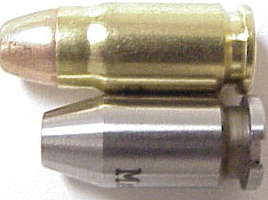 Allowable headspace in a firearm is typically .006″ greater than the maximum length of a standard cartridge or, in the case of the 357 SIG, 0.865″+.006″ = 0.871. However, the 357 SIG cartridge is positioned at the shoulder, so I was looking for a maximum dimension from shoulder to case head of 0.649″+.006″ or .655. The no-go gauge measured .659″ or .010″ beyond maximum case length. One quick note, there is a notch in the rim of the gauge. Because of the increased rim thickness of the gauge, the extractor won’t clear the rim without a notch. If the extractor is too wide to clear the notch, the extractor needs to be removed before checking with the a go/no-go gauge. In fact, anything that would interfere with the placement of the gauge, chamber or the recoil surface of the slide should be removed to prevent an erroneous reading.
Allowable headspace in a firearm is typically .006″ greater than the maximum length of a standard cartridge or, in the case of the 357 SIG, 0.865″+.006″ = 0.871. However, the 357 SIG cartridge is positioned at the shoulder, so I was looking for a maximum dimension from shoulder to case head of 0.649″+.006″ or .655. The no-go gauge measured .659″ or .010″ beyond maximum case length. One quick note, there is a notch in the rim of the gauge. Because of the increased rim thickness of the gauge, the extractor won’t clear the rim without a notch. If the extractor is too wide to clear the notch, the extractor needs to be removed before checking with the a go/no-go gauge. In fact, anything that would interfere with the placement of the gauge, chamber or the recoil surface of the slide should be removed to prevent an erroneous reading.
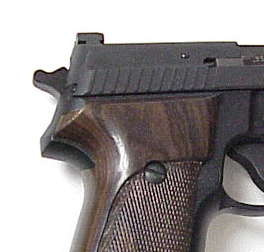 At one time, recoil operated semi-automatics were not generally considered to be as headspace critical as a bolt action rifle. With the increase in high pressure pistol cartridges moving what was once 18,000 PSI chamber pressure to upwards of 40,000 PSI, perhaps headspace has become progressively more critical. In addition, increased law enforcement use of these type of pistols makes reliability an absolute requirement.
At one time, recoil operated semi-automatics were not generally considered to be as headspace critical as a bolt action rifle. With the increase in high pressure pistol cartridges moving what was once 18,000 PSI chamber pressure to upwards of 40,000 PSI, perhaps headspace has become progressively more critical. In addition, increased law enforcement use of these type of pistols makes reliability an absolute requirement.
With the no-go gauge installed and indexed to clear the extractor, the SIG came close to closing, but it did not. The idea is not to slam the gun closed, but to ease the slide down on the gauge. Unfortunately, even with the slide held measurably open, the trigger could be pulled, and the hammer dropped. That can’t be good. As a result of this check, I do have a pretty good idea the gun is within chamber spec, but there are no dimensions scribed on headspace gauges, so I couldn’t directly verify correct headspace through measurement.
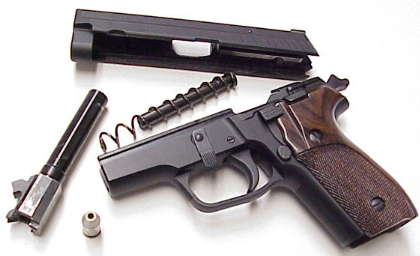 This is actually the only reason I had for buying the SIG. I got so tired of pulling recoil springs and plugs out of the ceiling and walls, I bought the SIG just for the take down lever feature, and gave away all of my 1911 design pistols…sure.
This is actually the only reason I had for buying the SIG. I got so tired of pulling recoil springs and plugs out of the ceiling and walls, I bought the SIG just for the take down lever feature, and gave away all of my 1911 design pistols…sure.
When it became obvious the gauge could demonstrate the gun was sound, but not provide the details of measurement, I immediately set out to see if I could use the no-go gauge in other ways. I popped open the gun and set up my dial indicator, then collected some: loaded ammo, handloaded ammo, fired brass and resized brass to try to better understand the dimensional relationship of all of the above.
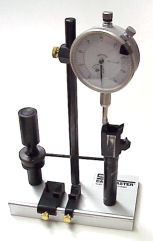 The last time I ran this setup, I made the assumption that the barrel tang was the closest surface to the recoil face of the slide, so by placing the barrel in a vertical position under a dial indicator, and measuring the difference between the height of the tang and the height of the case rim, I could detect excessive headspace – The height of the rim would be more than .006″ below the rear surface of the barrel tang. I used my RCBS case checker, which is certainly accurate enough for this purpose.
The last time I ran this setup, I made the assumption that the barrel tang was the closest surface to the recoil face of the slide, so by placing the barrel in a vertical position under a dial indicator, and measuring the difference between the height of the tang and the height of the case rim, I could detect excessive headspace – The height of the rim would be more than .006″ below the rear surface of the barrel tang. I used my RCBS case checker, which is certainly accurate enough for this purpose.
I took a look at my original article in the Real Guns archive and realized that reliable ignition came with positive readings (rim above the barrel tang), and misfires at relatively minor negative readings (rim below the tang) by as little as -.004″. Cases formed with an RCBS sizing die properly installed in my Ammo Master, all had excessive shoulder set back, resulting in negative readings. At the time, all factory Remington ammo ran between .005″ and .010″ above the barrel tang, Speer between -.005″ and +.012″ .
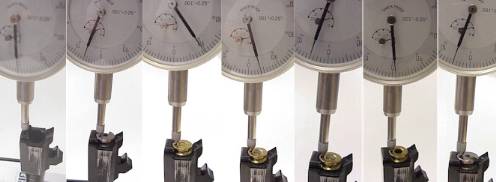
This time, when I ran the check with the dial indicator, the results were quite different. L to R –
-
Empty – tang position used to set zero on the dial indicator .000″
-
No-go gauge +.005″
-
Winchester white box ammo -.010″
-
Remington yellow box -.004″
-
Fired empty +.005″
-
Sized empty .000″
-
No-go gauge, verify gauge position +.005″
The negative measurements for Remington and Winchester factory ammo concerned me, and I will spend some time at the range investigating if these short rounds will yield the same results as the last time around – misfires. The resized case measurement threw me because I couldn’t get anything that wasn’t short from the Ammo Master, yet the Rock Chucker was popping out near perfectly dimensioned brass. The only difference between the two presses that would impact measurement are the shell plate and the shell holder. I need to investigate further and pinpoint the cause. The fired case measured identical to the no-go gauge, but I’m not sure at this point I understand the significance.
I’m going to take a break while I’m waiting for a go-gauge and a new depth micrometer to show up with UPS. I want to run some of the Remington and Winchester brass through the P229, and I need to fish around and verify some of the chamber dimensions so I can be accurate in determining where all of this dimensional instability is coming from. I’ll be back. I may be learning something about shell holders / plates, practice grade ammo vs. premium ammo and a pistol’s dimensional tolerance.
Thanks
Joe

Email Notification